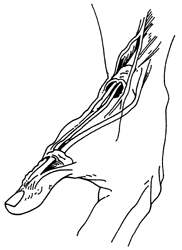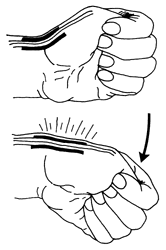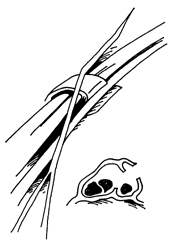What is it?
deQuervain’s tendinitis is a condition brought on by irritation or swelling of the tendons found along the thumb side of the wrist (Figure 1). The irritation causes the compartment (lining) around the tendon to swell, changing the shape of the compartment; this makes it difficult for the tendons to move as they should. The swelling can cause pain and tenderness along the thumb side of the wrist, usually noticed when forming a fist, grasping or gripping things, or turning the wrist.
What causes it?
The cause of deQuervain’s tendinitis is an irritation of the tendons at the base of the thumb. For example, awkward hand positions required by a new mother in caring for an infant is a common cause of this condition.
Signs and symptoms.
Pain over the thumb side of the wrist is the main symptom. The pain may appear either gradually or suddenly. It is felt in the wrist and can travel up the forearm. The pain is usually worse with use of the hand and thumb, especially when forcefully grasping things or twisting the wrist. Swelling over the thumb side of the wrist is noticed and may be accompanied by a fluid-filled cyst in this region. There may be an occasional “catching” or “snapping” when moving the thumb. Because of the pain and swelling, it may be difficult to move the thumb and wrist, such as in pinching. Irritation of the nerve lying on top of the tendon sheath may cause numbness on the back of the thumb and index finger.
Diagnosis.
A Finkelstein test is generally performed. In this test, the patient makes a fist with the fingers over the thumb. The wrist is then bent in the direction of the little finger (Figure 2). This test can be quite painful for the person with deQuervain’s tendinitis. Tenderness directly over the tendons on the thumb-side of the wrist is the most common finding, however.
Treatment.
The goal is to relieve the pain caused by the irritation and swelling. In some cases, your doctor may recommend resting the thumb and wrist by wearing a splint. Anti-inflammatory medication taken by mouth or injected into that tendon compartment may help reduce the swelling and relieve the pain. In some cases, simply not doing the activities that cause pain and swelling may allow the symptoms to go away on their own. When symptoms are severe or do not improve, surgery may be recommended. The surgery opens the compartment (covering) to make more room for the irritated tendons (Figure 3). Normal use of the hand can usually be resumed once comfort and strength have returned. Your hand surgeon can advise you on the best treatment for your situation.
Figure 1
Swelling about the tendons to the base of the thumb results in painful motion.
Figure 2
Finkelstein maneuver used to diagnose De Quervain’s tendinitis.
Figure 3
Surgery opens the sheath over the inflamed tendons.
Copyright © American Society for Surgery of the Hand.
All content copied with permission from ASSH (www.assh.org).



